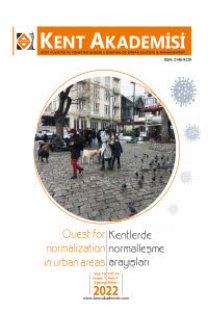Taş Duvarlarda Yüzey Bozunmaları
Taş bozunmaları, Taşın teknik özellikleri, Mimarlık, Taş malzeme, Bozunma nedenleri
Surface Deterioration in Stone Walls
Stone weathering, Technical properties of stone, Architecture, Stone material, Causes of deterioration,
___
- Çetin, C., (2012). Taş Malzeme Bilgisi ve Bozulmaları, Ders Notları- Ders Taş Bozulma Türleri, Ankara.
- Çetintaş S., Akboğa Z., (2020). Investigation of resistance to ageing by SO2 on some building stone, Construction and Building Materials, Volume:262, 120341.
- Dal, M., (2008). Kırklareli (Vize-Pınarhisar) Bölgesi kalkerlerinin restorasyonda kullanılabilirliği, Doktora Tezi, Trakya Üniversitesi Fen Bilimleri Enstitüsü, Edirne.
- Dal M., (2021). The Deterioration Problems Observed in the Natural Building Blocks of Saint George Church in Diyarbakır Province, Online Journal of Art and Design, volume 9, issue 1, January, Pg: 254-262
- Deplazes A., (2005). Constructing Architecture Materials Processes Structures a Handbook, Birkhauser Publishersfor Architecture - Berlin, ISBN: 10:3-7643-7312-1, Pg:32
- EL-Gohary M.A., (2017). Environmental impacts: weathering factors, mechanism and form saffected the stone decaying in Petra, Journal of African Earth Sciences, First available on 8 September, Vol. 135, pp. 204-212.
- Eriç, M., (1994). Yapı Fiziği ve Malzemesi, Literatür yayınları, İstanbul, ISBN: 978-01-8, sf: 17, 131, 80
- Güngör, Y., Angı, S., Yüzer, E., (2008). Doğal Taş Deyince, Granitaş Taş Kültürü Yayını, İstanbul.
- Gürdal E., Acun Özgünler S., (2016). Tarihi Yapıların Onarımında Doğal Taş Seçimi ve Kullanımı, Restorasyon ve Konservasyon Çalışmaları Dergisi, Sayı 16, sf: 27-35,
- Hegger M., Auch-Schwelk V., Fuchs M., (2006). Construction Materials Manual, ISBN-10: 3-7643-7570-1 Gmb Hand Co. KG. Munichpg: 38-39
- Hugues T.,Steiger L.,Weber J., (2005). Dressed Stone Types of Stone Details Examples, ISBN-10: 3-7643-7273-7, ISBN-13: 978-3-763-7273-6, Institutfür Internationale Architektur – Dokumentation, GmbH& Co.KG, Birkhäuser, pg: 108
- Iñigo A.C., Vicente-Tavera S., (2001). Different degrees of Stone decay on the iner and outer walls of a Cloister, ELSEVIER Buildingand Environment, Volume 36, Issue 8, Pages 911-917
- Kula D., Ternaux E., Hirsinger Q., (2009). Materiology the creative’s guide to material anstechnologies, ISBN: 978-3-7643-8424-1, pg: 91-96, Distribution: ISBN978-3-7643-8424-1, Basel/Switzerland
- Küçükkaya, A.G., (2004). Taşların Bozulma Nedenleri, Koruma Yöntemleri, Birsen Yayınevi, İstanbul.
- Megahed H. A., (2020). Hydrological and archaeological studies to detect the deterioration of Edfutemple in Upper Egypt due to environmental changes during the last five decades, Nov 6 2020,Volume:2, Article number:1952, Nature Applied Scieneces, Accession Number: WOS:000587311100002, eISSN: 2523-3971
- Öcal A. D., Dal M., (2012). Doğal Taşlardaki Bozunmalar, İstanbul Mimarlık Vakfı İktisadi İşletmesi.
- Patil S. M., Kasthurba A. K., (2020). Weathering of Stone monuments: Damage assessment of basalt and laterite, Materials Today: Proceedings, press, corrected prof Available online, pp. 1-12, Rives V., García-Talegón J., (2006). Decay and Conservation of Building stones on Cultural Heritage Monuments, Materials Science Forum Vols. 514-516 (2006) pp. 1689-1694, Trans Tech Publications, Switzerland
- Salvatore B., (2018). The geology of buildingstone: An understanding of the geological background of stone can help one make in formeddecisionsaboutitsuse, maintenance and restoration, Stone World, 2018, Issue 9, p38-44. 5p., ISSN 1052-6994, Accession Number 131601376
- Smith B.J., Gomez-Heras M., McCabe S., (2008). ‘Understanding the decay of stone-built cultural heritage’, Scholarly Journals, Progress in Physical Geography; London Vol. 32, Iss. 4, pp. 439-461. DOI:10.1177/0309133308098119, SAGE publications
- Stambolov T., Asperen de Boer J.R. Jvan., (1976). The Deterioration and Conservation of Porous Building Materials in Monuments, International Centre for The Study of The Preservation and The Restoration of Cultural Property, pg:8, Roma
- Yardımlı S., (2018). Madrasas as Educational Buildings in Van’ Cultural Landscape of VAN, TURKEY, Istanbul Aydın Unıversity Publications, E-ISBN 978-975-2438-33-0.
- URL-1, (2021). https://www.archdaily.com/900757/padre-pio-pilgrimage-church-renzo-piano-building-workshop/5b80678ff197cc442b000009-padre-pio-pilgrimage-church-renzo-piano-building-workshop-photo?next_project=no (Erişim Tarihi 06.02.2021)
- ISSN: 2146-9229
- Yayın Aralığı: Yılda 4 Sayı
- Başlangıç: 2008
- Yayıncı: Karadeniz Yazarlar ve Şairler Derneği
2000 Sonrası Kalkınma Planlarının Ulaştırma Politikaları Bakımından İncelenmesi
Trafik Akışının Yollardaki Fotovoltaik Paneller ile Elektrik Üretimine Etkisi
Saide Selin ERAY, İzzettin KUTLU
Merkezi İş Alanlarındaki Görsel Kirliliğin İncelenmesi: Balıkesir Merkezi İş Alanı Örneği
Mekansal Süreklilik Bağlamında Tarihsel Katmanların Değerlendirilmesi Antakya Kenti Örneği
Kadının Mekandaki Rolü ve Yöresel Konut Mimarisine Etkisi
Sultan Hamza-i Kebir Camii’nde Görülen Taş Bozunmaları
Şefika ERGİN, Büşra KARAHAN, Murat DAL
Günümüz Planlama Sistemindeki Yol Kademelenmesinin Mevzuattaki Değişim Kapsamında İncelenmesi
Pelin TATLI, Gökhan Hüseyin ERKAN
Ordu Kent Merkezindeki Yaya Dostu Bölgelerin Yaya Çevre İndisi Kullanılarak Belirlenmesi
Kırklareli Tarihi Çeşmelerinin Kültürel Miras Olarak Değerlendirilmesi
